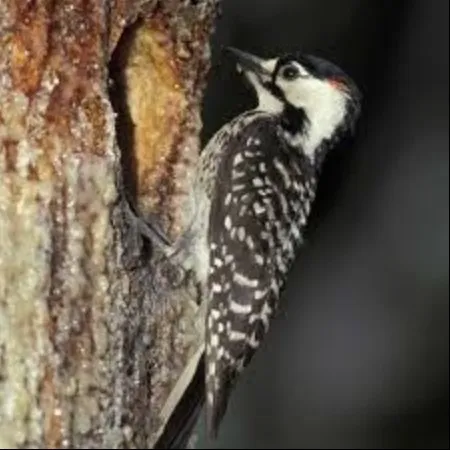Last Updated on: October 7, 2024
Would you like to know the identity of the woodpeckers visiting your backyard feeders daily? Well, nothing is more interesting than teaching your friends, siblings, kids, or grandkids about the different North Carolina woodpeckers.
Luckily…,
Identifying the woodpeckers in North Carolina is quite easy; you have to understand a few facts, and you’re good to go. For more details on the woodpeckers of North Carolina, please read on…
The 8 Common Woodpeckers In North Carolina
Out of the over 300 woodpecker species on the planet, only 22 woodpeckers are native to the United States. And out of the 22 woodpeckers native to the U.S., only eight birds call N.C. home, but this doesn’t mean that other species don’t visit this state. After all, most bird species fly to North Carolina in winter; therefore, we’ll start with the smallest woodpecker in this state.
1. Downy Woodpecker
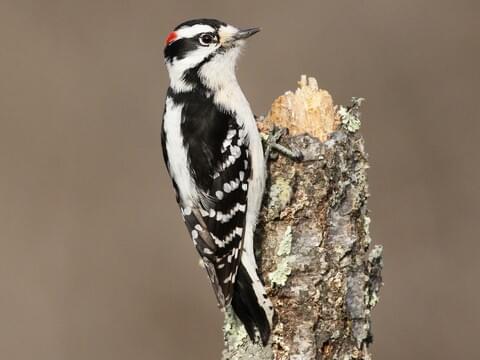
As aforementioned, N.C. is home to some birds native to the U.S., with the smallest woodpecker being the Downy woodpecker. In fact, it’s the smallest woodpecker in North America.
Unfortunately, the Downy woodpeckers are usually mistaken for the hairy woodpecker.
The Downy woodpecker resembles the hairy woodpeckers in many ways, but it is a third smaller and has a smaller beak. And being more common than the hairy woodpecker, this is usually the woodpecker that you see at the bird feeders.
The downy woodpeckers are not just any other black and white bird; they’re exceptional and blacker with a whitish patch on their back. Another exception feature that can help you identify this bird is the fact that the male has a red patch at the back of its head.
The downy woodpecker is known for its descending whinny calls and high-pitched pik sounds; plus, they can be quite fun to watch. It usually makes its nest in the cavity of dead trees, where it lays about eight eggs.
The Downy woodpeckers feed on nuts, acorns, berries, grains, and insects. In fact, you can find it drinking from your hummingbird’s feeder. Therefore, to attract them to your yard, you must install some upside-down suet feeders.
2. Hairy Woodpeckers
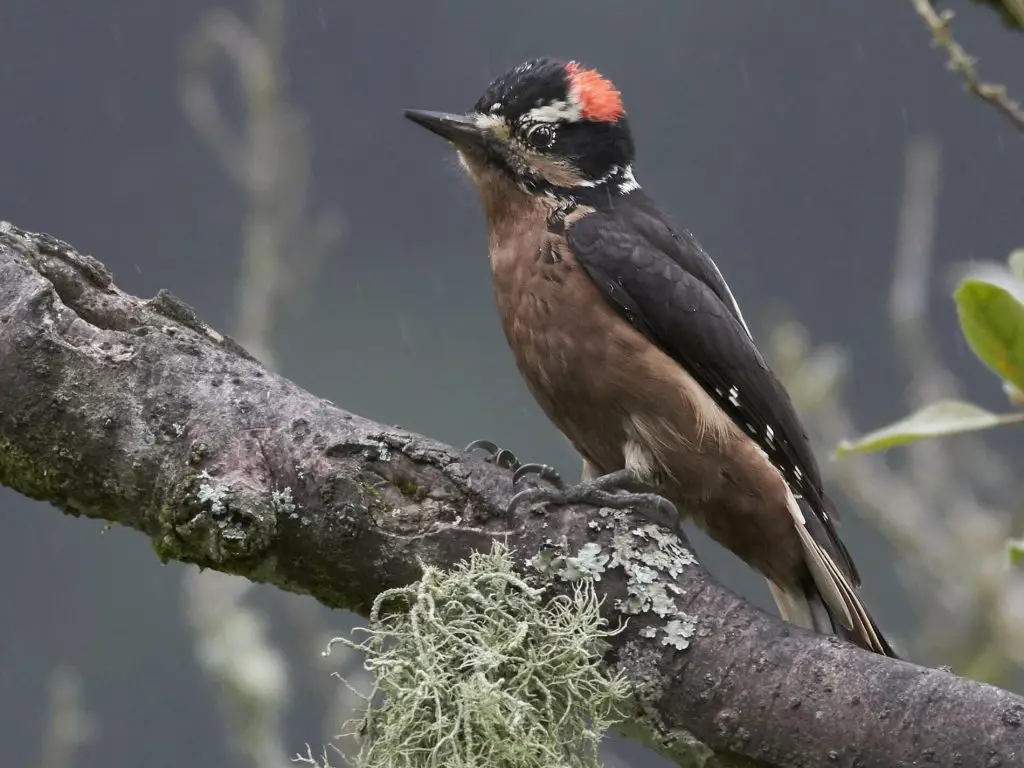
Another woodpecker that calls North Carolina home and resembles the downy is the hairy woodpecker. These birds have a striking remembrance, and the only way to can tell one from the other is by monitoring their size; after all, the hairy birds are bigger than the downy and have longer beaks.
Just like the downy, the hairy woodpeckers can be found in N.C., particularly in the woodlands, all year round. This medium-sized bird has a huge white patch on its back and white and black patterned feather, with the male having a red patch at the back of its head.
You can find this woodpecker in the woodlands on the main branches of huge trees. They can also be found in several habitats, including cemeteries, parks, and woodlots. This powerful small bird can be found on the backyard feeder and makes explosive peak calls or whinnying sounds.
Their diet is mainly composed of insects like bark beetles, ants, beetle larvae, millipedes, moth pupae, spiders, caterpillars, and bees.
3. Red-Bellied Woodpeckers
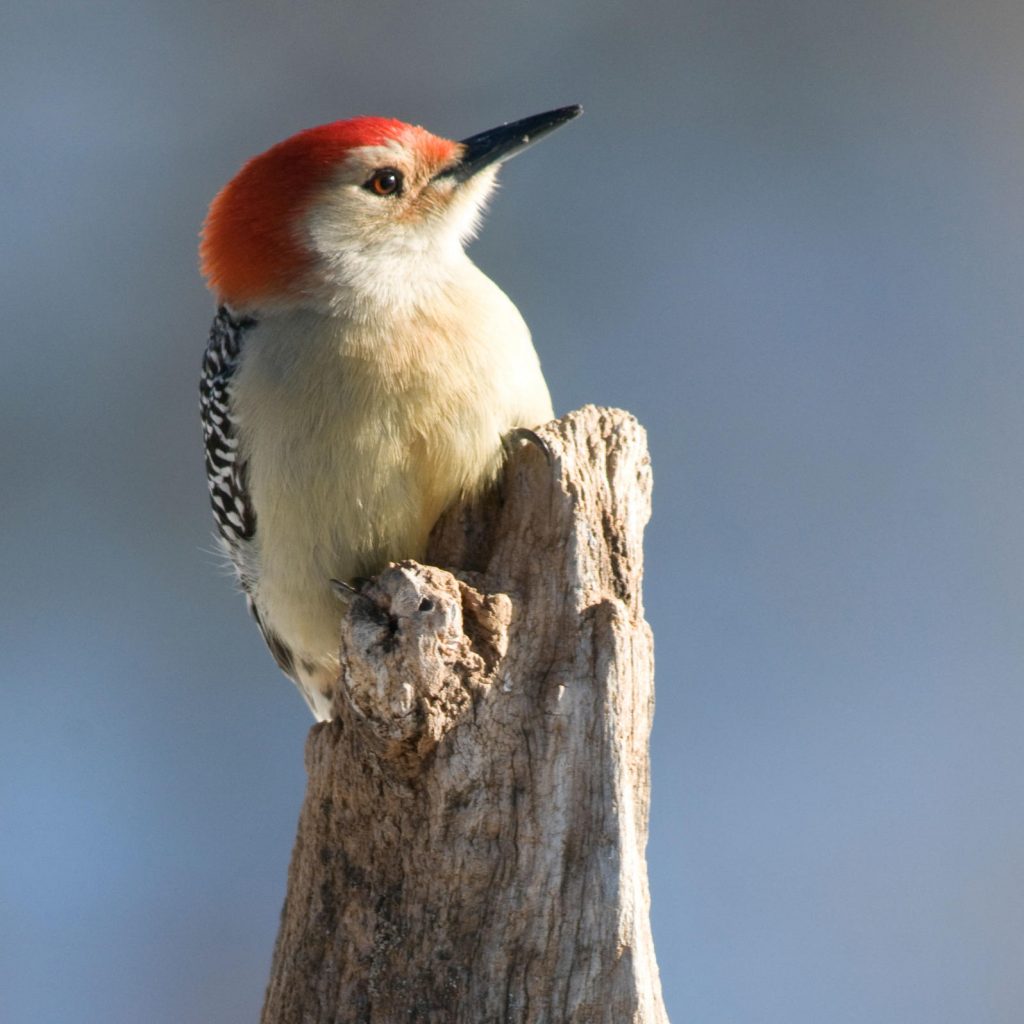
Another common visitor to our backyards in search of suet is the beautiful red-bellied woodpecker. This woodpecker has the same size as the hairy woodpecker, but it’s a bit bigger than the Downy. The Red-bellied woodpecker loves frequenting the bird feeders, particularly the suet feeder.
At first glance, you may be tempted to call this bird a red-headed woodpecker thanks to its red head, but you should resist it. Generally, the Red-bellied woodpecker does have a pale red belly which can be unnoticeable, especially when it’s up against your feeder. Therefore, to identify it, you should look at its white and black-barred wings and the reddish mohawk running down to its neck.
The Red-bellied woodpeckers are known for their distinctive loud rolling sounds; therefore, you can hear them before you see them.
They normally build their nests on dead trees and can use them for a number of years.
Unlike most woodpeckers, the Red-bellied Woodpecker has a long barbed tongue that sticks about 2inches out of its beak and helps it catch its prey from a deep crevice. They feed on nuts, fruit, grass seeds, and spiders, among other insects.
4. Red-Headed Woodpecker
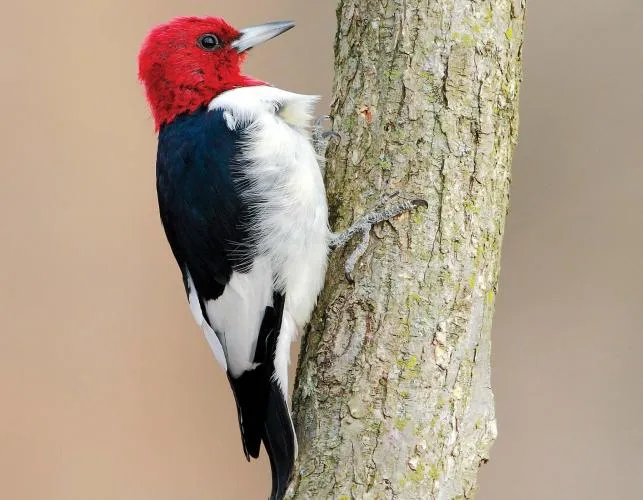
Unlike the previous woodpeckers in our list, the Red-headed woodpeckers are less common at the bird feeders. However, they can still be found in North Carolina all year long; it’s common in the western parts of this state. At times they can visit the feeder and then dart to the tree and hide the tasty treat at the bark of the tree for another day.
Unlike most woodpeckers, the red-headed woodpeckers are the easiest birds to identify. These medium-sized birds have a powerful spike bill and short tail. The Red-headed Woodpeckers have huge white bands on their tail and wings, black back, and white undersides.
They’re territorial creatures that can fiercely defend their nests and even destroy or remove the eggs of other birds. They are known for catching insects in flight and in tree crevices; a third of their meals include grasshoppers, honeybees, midge, and beetles. The other two-thirds include plants like berries, nuts, and seeds.
They can be found in dead timber, pine savannas, swamps, farms, and open woodlots.
Unfortunately, their population reduced by 70% between 1966 and 2014 thanks to habitat loss, but they’re not considered endangered.
5. Pileated Woodpecker

Just like the red-headed woodpecker, the pileated woodpecker is less common at the suet feeder, but it can be found in North Carolina all year round. The Pileated woodpeckers are the largest woodpeckers in North America. They can eat on suet feeders when offered but they’re very hard to attract and quite elusive. In fact, most folks who have tried attracting the pileated woodpecker to their yard failed most of the time!
Pileated woodpeckers are mostly black and white, but if you think they’re not stunning, you should wait for them to spread their wings. The white underside of its huge wings stands out. Plus, the male pileated woodpecker has a reddish stripe on its cheeks.
They can be found in drowned forests with dead trees and mature forests, so when looking for them, you should look for trees with some distinctive rectangular holes. Plus, they normally build their nest on a dead tree. Plus, they build new nests every year, leaving the old ones for other birds.
These birds love carpenter ants and can find them on fallen logs and dead trees. The Pileated woodpecker also eats termites, beetle larvae, nuts, and fruit like elderberry, dogwood, sumac berries, and blackberries.
6. Northern Flicker
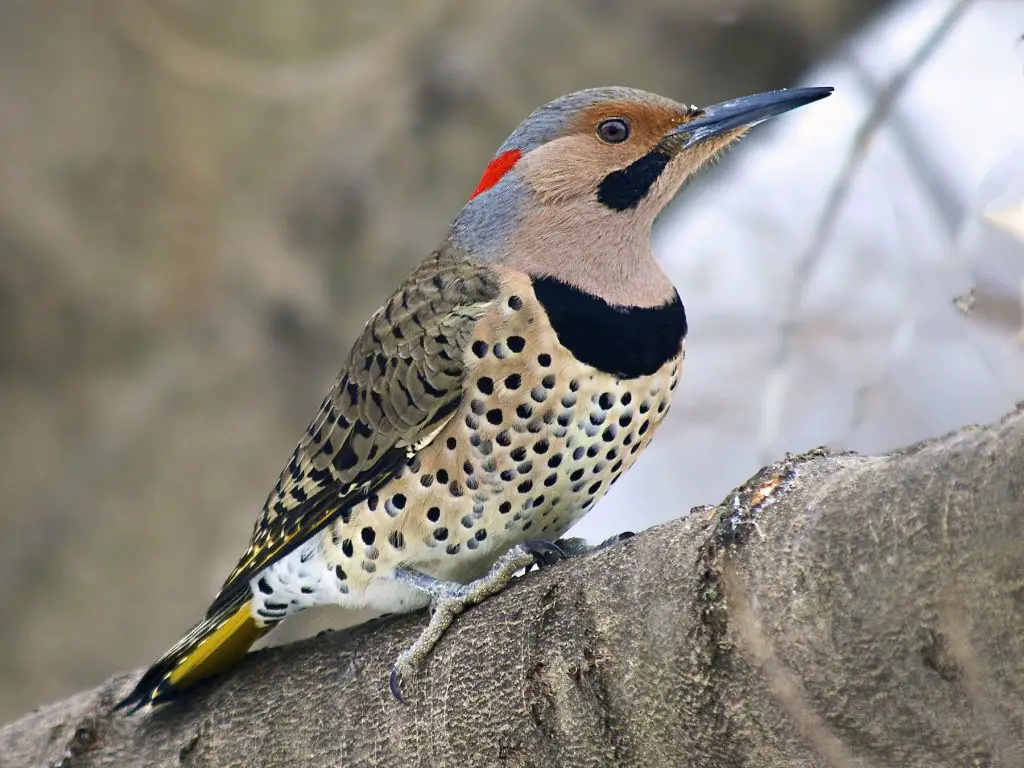
Even though they can be found all year round in North Carolina, this woodpecker species is way more common in winter. And that is because their numbers increase thanks to the Northern Flickers that migrate to this state. They’re very colorful creatures that frequent our backyard for some tasty treats.
Generally, there are two variations of the Northern flicker: yellow-shafted and red-shafted flickers.
But the yellow-shafted ones are more common in this state. The Northern flicker has a white patch on its rump and yellow on its tails and wings. These huge brown woodpeckers come with black-spotted plumages.
These birds can be seen in suburbs, parks, forest edges, and open wood, where you can find them foraging for food on the ground. When looking for them, you can listen to their loud ringing calls with a sharp, piercing yelp. The Northern flicker nests in a tree cavity where it lays about eight eggs.
They mainly feed on beetles and ants and consume seeds and fruit. So you can find them digging for food using their curved bills.
7. Yellow-Bellied Sapsucker
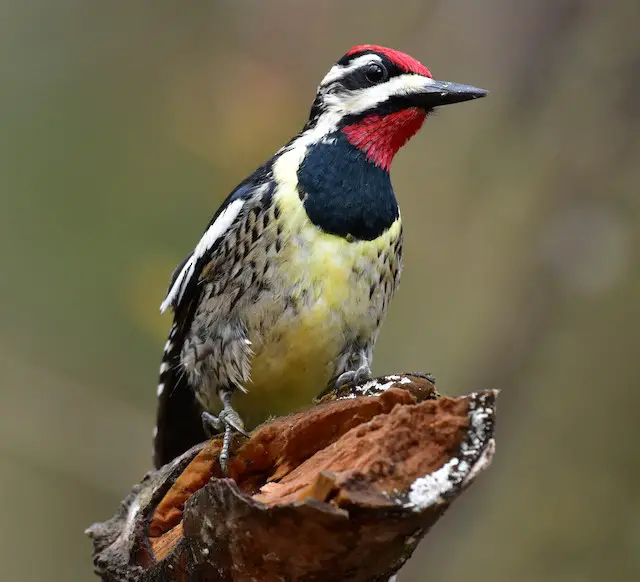
Generally, the yellow-bellied sapsuckers are not frequent visitors to our bird feeders, but at times they can show up at the suet feeders. These migratory birds can be found in N.C. in winter after breeding in Canada and other northern states. The yellow-bellied sapsucker is a small bird about the same size as robins.
The Yellow-bellied sapsuckers are mostly black with a red forehead, while the males have red throats. The Yellow-bellied sapsucker has a black and yellow chest, lighter underbodies, and red feathers below and above the beak.
When looking for a Yellow-bellied sapsucker, you should look for a young deciduous forest where it loves nesting on maple or birch trees. In fact, you can find some neat rows of sap wells on these trees. They usually stick their bill in these sap wells and use their tongue to remove as much sap as possible.
The yellow-bellied sapsuckers are known for their unique loud mewing calls.
8. Red-Cockaded Woodpecker
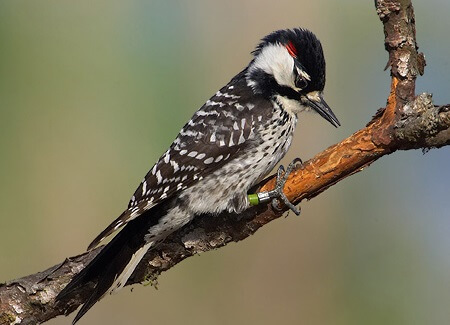
Another unique woodpecker found in this state that frequents the bird feeders is the red-cockaded woodpecker. This species is quite common in some parts of the Southeast United States, and in North Carolina, you can find them in some of the national pine forests where they roost and nest.
Unlike the other woodpeckers on our list, the red-cockaded woodpecker is considered endangered by the American Fish and Wildlife Service.
In fact, they’re not as common as they were in the past in the south. So when looking for them, you should look for forests with heart fungus disease; after all, this disease makes the pine soft and easy to excavate.
These small birds have black backs that help them blend with their surroundings. They come with some white and black stripes on their backs. They also have a pale underside with white patches on their cheeks. On the other hand, the male red-cockaded woodpecker has a red line on his cheek.
To attract them to your backyard, you must plant some berries-producing plants like elderberries, bayberries, grapes, and hackberries; they also love sunflower seeds.
Roaming Tip: Your woodpecker adventure doesn’t stop here! Proceed to our next article to learn what’s next — Pennsylvania Woodpeckers.
Watch This!
Frequently Asked Questions
How Can You Attract The Downy Woodpeckers To Your Yard?
Other than installing an upside-down suet feeder in your backyard, you can also add a birdbath, but make sure it’s isolated and in a shaded place. In fact, a ground bird bath can easily get their attention. They also consume sunflower seeds and peanuts, so a perfect mixture of its favorite foods can do the trick.
What Is The Biggest Woodpecker In North Carolina?
Generally, the biggest woodpecker species in North America that calls North Carolina home is the pileated woodpecker. It is actually the remaining huge woodpecker in that U.S. that’s not considered extinct.
What Woodpecker Resembles The Downy But Is A Bit Bigger?
The hairy woodpeckers are the only woodpecker species that closely resembles the downy but is a bit bigger. In fact, the hairy woodpecker is about 9 inches from its tail to the bill, while the downy is about 6.5 inches long.
Conclusion
As aforementioned, North Carolina is home to some of the most beautiful woodpecker species that closely resemble each other. In fact, the Pileated woodpecker is the largest, while the downy is considered one of the smallest species. So instead of just guessing their names, why don’t you use the above details to identify the different species that visit your backyard?

